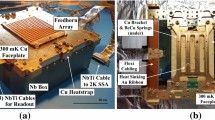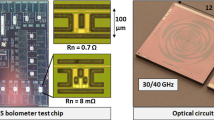Abstract
SPT-3G is a polarization-sensitive receiver, installed on the South Pole Telescope, that measures the anisotropy of the cosmic microwave background (CMB) from degree to arcminute scales. The receiver consists of ten 150-mm-diameter detector wafers, containing a total of \(\sim \,16{,}000\) transition-edge sensor (TES) bolometers observing at 95, 150, and 220 GHz. During the 2018–2019 austral summer, one of these detector wafers was replaced by a new wafer fabricated with Al–Mn TESs instead of the Ti/Au design originally deployed for SPT-3G. We present the results of in-laboratory characterization and on-sky performance of this Al–Mn wafer, including electrical and thermal properties, optical efficiency measurements, and noise-equivalent temperature. In addition, we discuss and account for several calibration-related systematic errors that affect measurements made using frequency-domain multiplexing readout electronics.





Similar content being viewed by others
Notes
The parasitic impedance measured in the superconducting state is dominated by reactances that produce a characteristic frequency dependence across all detector wafers and readout modules.
Note that saturation powers reported in [19] do not include this correction.
References
J.W. Henning et al., Astrophys. J. 852(2), 97 (2018)
W.L.K. Wu et al. (2019), arXiv: 1905.05777 [astro-ph.CO]
B.D. Sherwin et al., Phys. Rev. D 95(12), 123529 (2017)
A. Manzotti et al., Astrophys. J. 846, 1 (2017)
P.A.R. Ade et al., Phys. Rev. Lett. 121, 221301 (2018)
L.E. Bleem et al., Astrophys. J. Suppl. 216(2), 27 (2015)
M. Hilton et al., Astrophys. J. Suppl. 235(1), 20 (2018)
J.D. Vieira et al., Astrophys. J. 719, 763–783 (2010)
M.B. Gralla et al. (2019), arXiv: 1905.04592 [astro-ph.GA]
N. Whitehorn et al., Astrophys. J. 830(2), 143 (2016)
B.A. Benson et al., Proc. SPIE Int. Soc. Opt. Eng. 9153, 91531P (2014)
A.N. Bender et al., Proc. SPIE Int. Soc. Opt. Eng. 10708, 1070803 (2018)
F.W. Carter et al., J. Low Temp. Phys. 193(5-6), 695–702 (2018)
J.W. Henning et al., Proc. SPIE Int. Soc. Opt. Eng. 8452, 84523A (2012)
D. Li et al., J. Low Temp. Phys. 184(1-2), 66–73 (2016)
K.N. Abazajian et al. (2016), arXiv: 1610.02743 [astro-ph.CO]
C.M. Posada et al., Proc. SPIE Int. Soc. Opt. Eng. 9914, 9914 (2016)
A. N. Bender et al. (2019), arXiv: 1907.10947 [astro-ph.IM]
D. Dutcher et al., Proc. SPIE Int. Soc. Opt. Eng. 10708, 107081Z (2018)
A. Nadolski et al., Proc. SPIE Int. Soc. Opt. Eng. 10708, 1070843 (2018)
Acknowledgements
The South Pole Telescope is supported by the National Science Foundation (NSF) through Grant PLR-1248097. Partial support is also provided by the NSF Physics Frontier Center Grant PHY-1125897 to the Kavli Institute of Cosmological Physics at the University of Chicago, and the Kavli Foundation and the Gordon and Betty Moore Foundation Grant GBMF 947. Work at Argonne National Laboratory, including Laboratory Directed Research and Development support and use of the Center for Nanoscale Materials, a US Department of Energy, Office of Science (DOE-OS) user facility, was supported under Contract No. DE-AC02-06CH11357. We acknowledge R. Divan, L. Stan, C.S. Miller, and V. Kutepova for supporting our work in the Argonne Center for Nanoscale Materials. Work at Fermi National Accelerator Laboratory, a DOE-OS, HEP User Facility managed by the Fermi Research Alliance, LLC, was supported under Contract No. DE-AC02-07CH11359. NWH acknowledges support from NSF CAREER Grant AST-0956135. The McGill authors acknowledge funding from the Natural Sciences and Engineering Research Council of Canada, Canadian Institute for Advanced Research, and the Fonds de recherche du Qubec Nature et technologies. JV acknowledges support from the Sloan Foundation.
Author information
Authors and Affiliations
Corresponding author
Additional information
Publisher's Note
Springer Nature remains neutral with regard to jurisdictional claims in published maps and institutional affiliations.
Rights and permissions
About this article
Cite this article
Anderson, A.J., Ade, P.A.R., Ahmed, Z. et al. Performance of Al–Mn Transition-Edge Sensor Bolometers in SPT-3G. J Low Temp Phys 199, 320–329 (2020). https://doi.org/10.1007/s10909-019-02259-7
Received:
Accepted:
Published:
Issue Date:
DOI: https://doi.org/10.1007/s10909-019-02259-7




